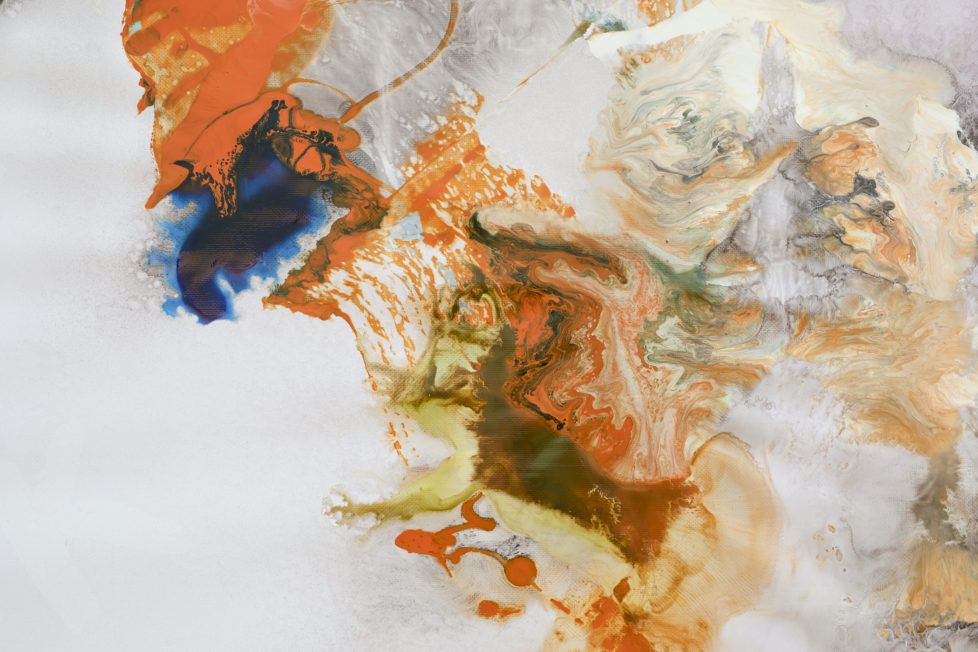
On the surface, Ragna Bley and Inger Ekdahl have little in common besides being Swedish women engaged in abstract painting. At Malmö Konsthall, these particular artists have been juxtaposed in a presentation that bears only their names – as if their practices offer so little common ground that it proved impossible to come up with a shared title framing the double presentation.
Ragna Bley (b. 1986) is by far the most dominant presence in the exhibition. Her large paintings hang from the ceiling on steel wires, forming a long procession that extends through most of the exhibition space. Here we find two different series of works presented back to back, giving us one experience as we move from the entrance to the back wall, and a completely different one as we go the opposite way.
One series has a soft, transparent, and organic feel prompted by Bley’s technique of working with heavily diluted acrylic paint on unprimed canvas. The pigments alternately flow out across the surface, leaving colourful traces of varying intensity as the water evaporates, or are absorbed into the canvas support, causing it to appear dyed rather than painted. Across these blots of colour – all merging, dissolving, and blurring as they slide into each other – Bley has added clearly defined brushstrokes to outline certain structures, as if to regain some control over the free-flowing blotches, or perhaps to reintroduce a figure-ground relationship to the otherwise flat paintings.
The technique is reminiscent of Helen Frankenthaler’s soak stain paintings from the 1950s onwards, a kind of action painting where diluted paints formed their own patterns on unprimed canvases, aided by Frankenthaler as she tilted the wet canvases from side to side to form traces of running colours.
As we follow the procession of paintings in the opposite direction, we take in a series of works, Truckers (2019), that does the exact opposite. Here the canvas has been replaced by PVC, a support on which Bley has worked with an enamel paint that cannot penetrate the surface. Instead, the paint pools on the surface of the work, causing the plastic material to buckle and curl underneath as it dried. The variously coloured paints slip in and out of each other, merging and blending in some places, while in other places they lie next to each other, forming the kinds of patterns that petrol makes in a puddle.

In both series, it is remarkable to note the major role played by the blank canvas. Due to the rather unmanageable process, large – and, one must assume, relatively arbitrary – areas are left untouched, with no trace of either enamel or acrylic, creating negative forms which become part of the overall composition.
In the Truckers series, patterns of short words are printed onto the PVC – Lie, Be, Arm, and similar – as if to give the blank background its own secret language. Just as the enamel cannot penetrate the surface, I fail to penetrate this linguistic layer, which the press text informs us consists of “references to science-fiction literature, science, biopolitics and other subjects important to Bley.”
Of course, the choice to downplay the linguistic aspect of the exhibition reflects an active decision to maintain a focus on the purely painterly. This aspect holds centre stage in a third series displayed in the venue’s courtyard, where five canvases partially painted with pigments and organic matter such as coffee and tea await completion by the elements. By the time I visited, a few days after the opening, not much had happened; one can only assume that these paintings will change noticeably during the exhibition period as rain and moisture cause the pigments to dissolve and run down the canvases.
It is this process, poised somewhere between control and spontaneity, that forges a connection between Bley’s vast explosions of colour and Inger Ekdahl’s small, almost monochrome formats. Ekdahl (1922–2014) was an early modernist in Sweden and among the first women to work non-figuratively. As is often the case with female pioneers, she has remained relatively overlooked until recently.
Accordingly, Malmö Konsthall has chosen to present her entire oeuvre in a chronological retrospective hang featuring works dating from the 1950s to her death. Visitors can follow her development from action painting to the super-tight compositions she called ‘Harmonigrams’, and which were typical of her late years. The latter are particularly interesting, consisting of completely symmetrical and neatly constructed geometric figures which unshackle themselves from the surface like optical illusions, becoming three-dimensional representations of rhythm and movement.
To me, the juxtaposition of Bley and Ekdahl makes little sense. Of course, they both share a common interest in automated processes, and there may be a point in the fact that both artists’ works seem to jitter restlessly in a state of arrested movement. Visually, however, they do not complement each other particularly well. Ekdahl’s delicate small formats disappear almost entirely in the narrow semi-dark back galleries to which they have been banished in order to make room for Bley’s huge works. Those, in turn, are never fully unfolded – conceptually or linguistically. Perhaps the reason is that the venue wanted to maintain a focus on what the two artists have in common: they are both women who work with abstract painting and automated processes. To my mind, this is too flimsy a basis for a two-artist show.



















